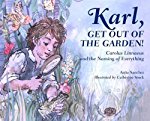Through the Looking Glass Children's Book Reviews
Karl, Get Out of the Garden!
Illustrator: Catherine Stock
Nonfiction Picture Book
For ages 6 to 8
Charlesbridge, 2017 ISBN: 978-1580896061
Karl Linne’s mother had big dreams for her son. She hoped that he would grow up to become a lawyer, scholar, or minister, and so she expected him to stay indoors and study. The problem was that Karl did not care for schoolwork, and he was always sneaking out of the house so that he could explore the garden.
From a very early age Karl developed a love for growing things, and animals, and he would happily spend hours among the flowers, and watching insects. When Karl’s teachers told his parents that their son did not have the disposition for becoming a minster, Karl’s father thought that Karl should train to be a shoemaker instead. Luckily, one of Karl’s teacher’s came up with another suggestion. In those days doctors had to know a lot about plants, and since Karl loved to learn about plants, training to become a doctor seemed like a sensible thing to do.
Karl studied hard and soon began to learn about medicinal herbs. However, he soon realized that there was a problem. No one could agree about what the plants were called. Even doctors, who knew a lot of Latin, could not agree about what the scientific names of plants were. In short, the system for the naming of plants - and animals too it turned out – was chaotic.
Karl decided that he would create a simple system for naming living organisms, one that people could easily use to identify plants and animals. Though the job was a monumental one, Karl got to work. He first divided the world of living organisms into two kingdoms; the plant kingdom and the animal kingdom. Each kingdom was then divided into groups and then classes. Each organism was given a Latin name that had two parts, and that was short and “Easy to remember.” For example, the dog rose’s new name was Rosa canina, which was a huge improvement on it its old name, which was ridiculously long.
Karl traveled all over his native land of Sweden naming plants. Then he went to Lapland and named more plants. He also named animals but this presented challenges. Animals were much more complicated than plants and therefore harder to classify, so Karl decided that he had to learn about how animals were “put together on the inside” before he named them. When he did this Karl discovered that many animals had been placed into the wrong family. For example, bats were mammals and not birds, and whales were mammals and not fish.
Some classes of animals, the insects for example, were so packed with organisms that Karl had to divide them into groups called orders, which were then split again into families. Families were divided into a group called a genus and each genus was made up of species.
Though Karl’s method of classifying animals was more scientific and accurate, there were many people who did not approve of his work. How could Karl say that humans belonged in the same family as cats and gorillas? It was outrageous they said. The Pope even went so far as to ban Karl’s books and said that they should be burned.
Luckily Karl, like so many innovators before and after him, chose to ignore his critics and he kept on naming things. He also taught young people about the natural world and when they went out to explore other lands, these young people took Karl’s ideas with them. People began to discover how valuable Karl’s classification system was. If a plant had one name, that name could be used by people all over the world!
Ever since it was developed, gardeners, zoologists, botanists, (and so many other ologists) have depended on Carolus Linnaeus’ classification system. Thanks to him, these scientists have an easy-to-understand system of categorizing living things, which also helps them to understand how these organisms are related to each other.
This splendid book serves as an excellent tribute to a man who gave the world so much. Throughout the book quotes from Linnaeus’ writings offer us insight into his character, adding further depth to the already rich narrative and beautiful artwork.
At the back of the book an author’s note offers us further information about Carolus’ life and his work.




